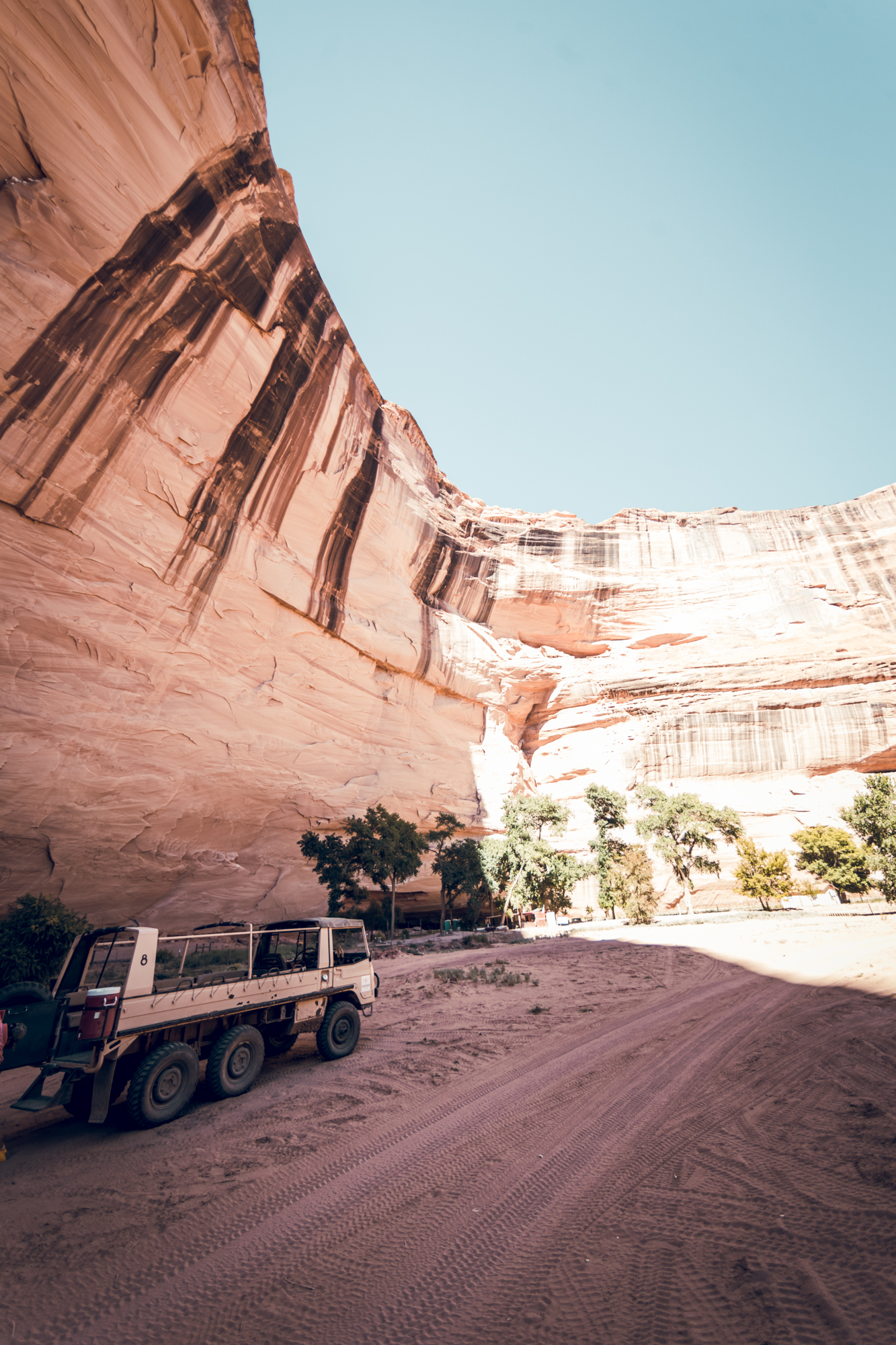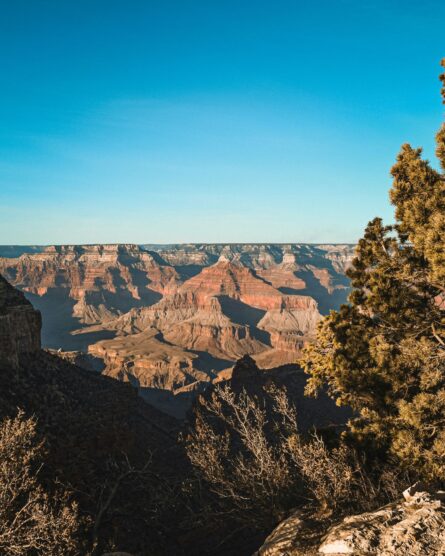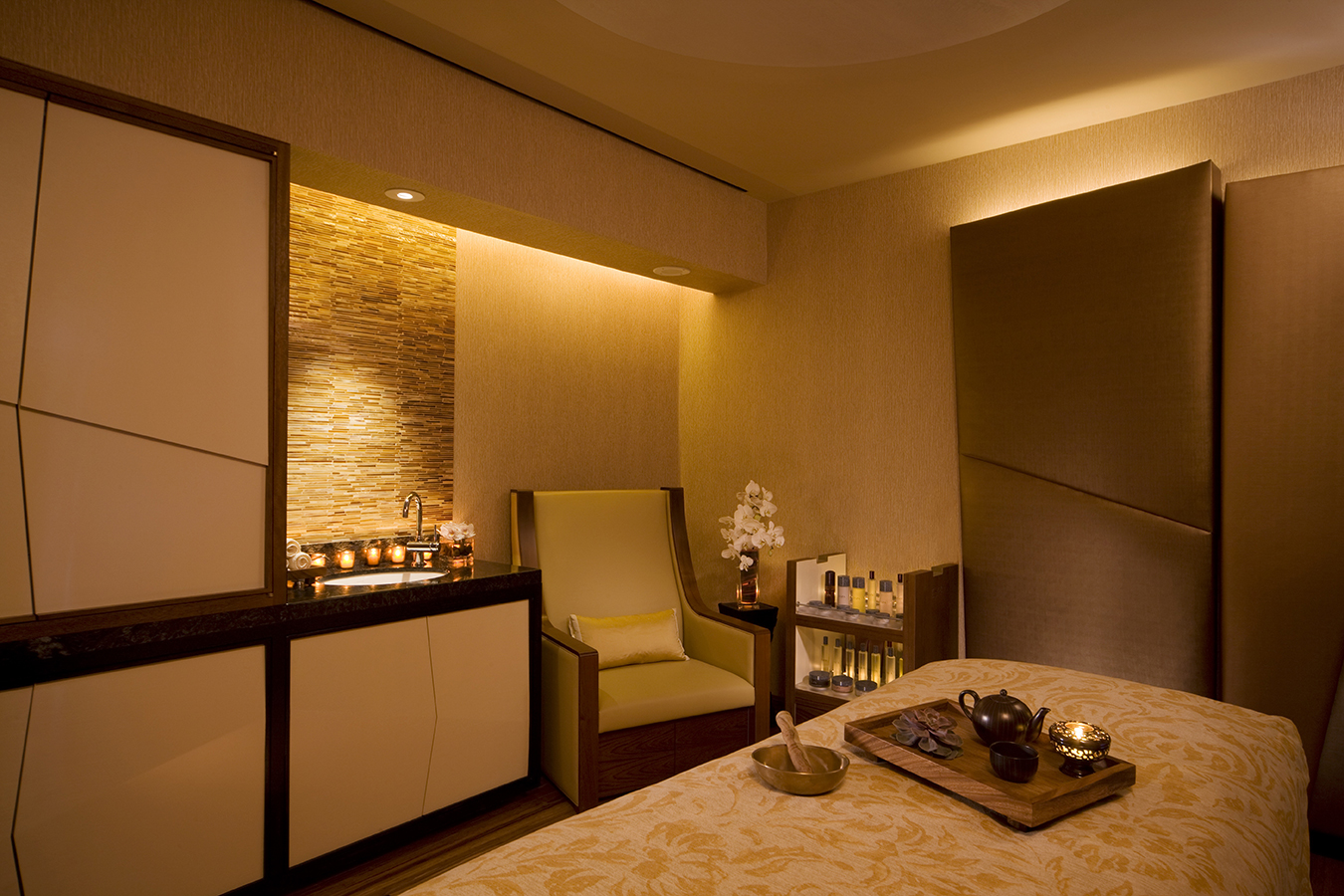Journeying Through Indigenous Lands in Northern Arizona
The state is home to 22 federally recognized Indigenous nations.

Photo of Chinle courtesy of Thunderbird Lodge.
A deep sense of awe washes over me as our jeep bounces over sandy mounds and dusty-rose terrain through Canyon de Chelly’s striking sienna sandstone walls that jut high into the baby-blue sky. The sacredness of these lands on the Navajo Nation in northern Arizona resonates thanks to petroglyphs, magnificent cliff dwellings, and hundreds of Pueblo ruins dating from 350 to 1300 AD that enable history to unfold as you traverse these trails.
“In our Navajo language, it’s pronounced ‘Say-It’ is how we remember the canyon,” Navajo guide Harold Bia says as he stands before a landscape of crimson rock. “It’s spelled Tséyi’. I’ve been told that what it means is ‘inside the rock.’ It’s been a special and significant place for thousands of years.”
Chinle serves as the gateway to Canyon de Chelly, and it has indeed been a significant place that has provided food, water, and shelter for Indigenous communities for more than 5,000 years. These communities include Archaic, Basketmakers, Ancestral Puebloans, and Hopi. Today, about 40 Navajo families live and farm in the canyons. Nearly 84,000 acres of tribal lands were established as the Canyon de Chelly National Monument under the National Park Service by President Herbert Hoover in 1931.
Canyon de Chelly has been considered the centre of the Navajo (Diné) universe. According to legend, a 243-metre spire called Spider Rock in the canyon is where Spider Woman first wove the web of the universe.
Chinle is just one of many stops to uncover Indigenous culture on the Colorado Plateau, which comprises a series of mesas centred on the four corners of Arizona, Utah, Colorado, and New Mexico.
If you’re keen on discovering the past and present of the original keepers of the land, here are some spots to consider along your way.
Flagstaff – Winslow Winslow – Holbrook
A three-day road trip in Phoenix begins by driving to Flagstaff to head to Montezuma Castle, a national monument in the Verde Valley. The well-preserved five-storey cliff dwelling has 20 rooms.
Next, a stop at the Museum of Northern Arizona, which sits at the base of the San Francisco Peaks, is in order. The Native Peoples of the Colorado Plateau permanent exhibition presents the histories, values, and cultures of 10 tribes. To select the more than 350 items on display, the curators partnered with 42 members of the Colorado Plateau tribes, including the Acoma, Dil’zhe’e Apache, Diné (Navajo), Havasupai, Hopi, Hualapai, Southern Paiute, Southern Ute, Yavapai, and Zuni communities. The museum has several visiting Indigenous exhibits as well.
Walnut Canyon National Monument
Next up is a hike at Walnut Canyon National Monument. When descending onto the canyon’s Island Trail, you can almost feel the presence of the Pueblo community that called this home more than 700 years ago. You can explore 25 cliff-dwelling rooms once inhabited by the Northern Sinagua people, plus the dramatic geology, varied vegetation, and abundant wildlife that made their lives possible. The visitors centre provides more information about the communities shaped by the walls of the canyon.

Canyon de Chelly
Hubbell Trading Post
A drive from Walnut Canyon to Winslow brings us to the oldest continuously operating trading post on the Navajo Nation, the Hubbell Trading Post. Usually owned by non-Navajo people, trading posts were meeting places for the Navajo and settlers who came to the area to trade. They were often the centre of commercial, cultural, and social life for the Navajos. This historic centre is filled with gorgeous woven rugs, hand-carved jewellery, and more.
Petrified Forest/Little Painted Desert
In Little Painted Desert, the mesas climb up in stratified layers pigmented with pink, orange, and purple mineral deposits. Once native grasslands, much of this colourful area lies in remote areas of the Petrified Forest on the Navajo Nation. Trees turned to stone and fossilized animal bones from more than 200 million years ago dot this area of strangely eroded badlands. For thousands of years, Indigenous people have called this home. Petroglyphs created by Pueblo people between 650 and 2,000 years ago can be found by wandering through this bewitching forest. The petroglyphs depict people living, farming, and hunting along the Puerco River.
Where to stay: Thunderbird Lodge
The historic Thunderbird Lodge is the only hotel in Canyon De Chelly National Monument and is Navajo owned and operated. With 69 hotel rooms, and a historic trading post offering Indigenous jewellery, fine arts and crafts, and rugs made by local Navajo weavers, this lodge is a must-stay. Its cafeteria-style restaurant serves regional specialties including local favourites, Navajo tacos, and frybread.

Holbrook – Ganado – Chinle
Navajo National Monument
The Navajo National Monument preserves three of the most intact cliff dwellings of the ancestral Puebloan people. The visitor centre features museum exhibits about ancestral Puebloan people, modern Navajo culture, and the Betatakin cliff dwelling. Behind the visitor centre, two short trails take visitors to an overlook of the Betatakin (called Talastima by the Hopi) cliff dwelling and another of a relict forest left over from the Ice Age. Signs along the trails identify native plants and how the Hopi and Navajo have traditionally used them.
Grand Canyon National Park
Standing before the South Rim of the Grand Canyon elicits grand awe. Its stratified psychedelically coloured canyon walls plunge down into this mile-deep canyon. Carved by the Colorado River, which makes a dramatic 445-kilometre-long slash through the terrain, it’s fitting that this stop is the grand finale on this special road trip. Arizona’s best-known and busiest landmark is also where Native Americans lived in and around 12,000 years ago.
The Desert View Watchtower en route to the Grand Canyon Village is a National Historic Landmark. Constructed in 1932, it was designed in a similar architectural style to buildings of the ancestral Puebloan people of the Colorado Plateau, and its View Room is modelled after a traditional Native American kiva.
The Indigenous lands in Northern Arizona have one of the finest examples of arid-land erosion in the world and offer insight into how Indigenous people lived. Going home with a wealth of knowledge is a grand finale for a grand road trip.




